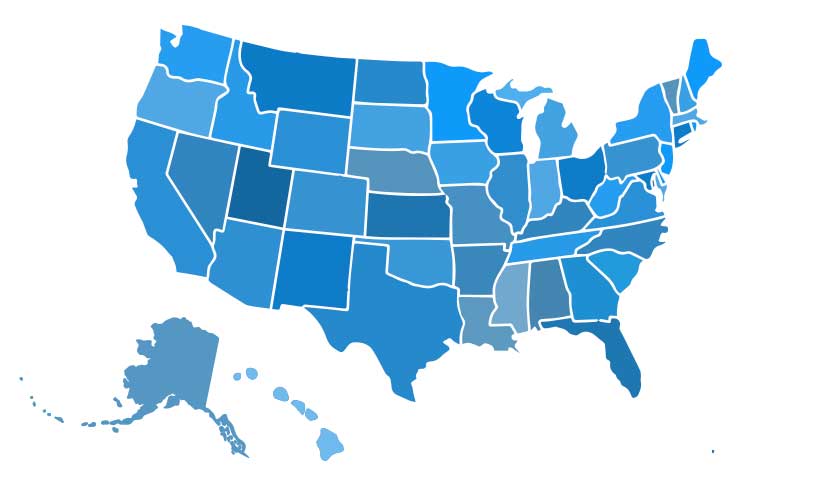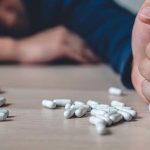In 2021, the average life expectancy in the United States dropped to 76.4, the lowest level since 1996. This drop reflects the surge of COVID-19 deaths. However, it’s also related to the recent rise in fatal drug overdoses.
The Link Between Drug Overdose & Life Expectancy
According to the National Center for Health Statistics at the Centers for Disease Control and Prevention (CDC), drug overdose deaths have increased five-fold over the past two decades. In 2021, the annual rate of U.S. overdose deaths topped 100,000 for the first time ever.
This sharp rise in overdose deaths has contributed to a sharp drop in average lifespan. Most years, U.S. life expectancy only changes by 0.1 or 0.2 years. However, between 2020 and 2021, it dropped from 77 to 76.4, a 0.6-year difference.
CDC data shows that overall death rates in 2021 increased for all age groups (except infants under one year). The biggest increase occurred among those aged 35 to 55, which is also the group most impacted by fatal overdoses.
Besides drug overdose, other leading causes of death that contributed to the drop in U.S. life expectancy include:
- COVID-19
- heart disease
- Alzheimer’s disease
- chronic liver disease
- chronic lower respiratory diseases
- stroke
- kidney disease
- diabetes
Explaining The Surge In Drug Overdose Deaths
The surge in overdose deaths has been linked to two main issues: the rise of fentanyl and the COVID-19 pandemic.
The Rise Of Fentanyl
According to CDC reports, most drug overdose deaths involve synthetic (human-made) opioids. In 2021, these deaths increased by 22%.
The most popular synthetic opioid is fentanyl. This powerful substance is up to 50 times stronger than heroin and 100 times stronger than morphine.
While it’s extremely powerful, fentanyl is also cheap and easy to make. That’s why many drug dealers lace it in other substances, including powders (such as heroin, cocaine, and methamphetamine) and pills (such as Xanax, OxyContin, and Adderall).
In most cases, you can’t tell when a drug has been laced with fentanyl. That means anyone who uses street drugs could ingest fentanyl without realizing it and overdose.
In 2021, the United States Drug Enforcement Administration (DEA) seized more than 379 million fatal doses of fentanyl. That’s enough to kill every U.S. citizen.
The COVID-19 Pandemic
The COVID-19 pandemic has brought significant stressors, including job loss, the deaths of loved ones, and an overwhelming sense of uncertainty.
To cope with these stressors, many Americans turned to drugs. Some of them tried drugs for the first time. Others relapsed after recovering from drug addiction.
Indeed, at the start of the pandemic, relapse rates soared as lockdowns prevented people from accessing addiction treatment. This surge in drug use contributed greatly to the surge in overdose deaths.
How To Prevent Drug Overdose Deaths & Increase Life Expectancy
According to addiction specialists, we can fight the overdose crisis and increase life expectancy by making addiction treatment more accessible and comprehensive.
Culturally Sensitive Care
In 2020 and 2021, non-Hispanic American Indian or Alaska Native people had the highest overdose mortality rates, followed by non-Hispanic Black people. At the same time, Native Haiiwan or other Pacific Islanders experienced a 47% increase in overdose deaths.
To reduce deaths among these groups, addiction treatment providers must provide culturally sensitive care, which is care that addresses each patient’s unique social and cultural needs.
Trauma-Informed Care
Similarly, more treatment providers should be trained in trauma-informed care. This type of care aims to acknowledge and address trauma, which is one of the most common risk factors for addiction.
Expanded Access To Medication
In addition, numerous saves could be saved if lawmakers expanded access to buprenorphine and methadone. These medications can help treat opioid addiction by easing cravings and withdrawal symptoms.
How You Can Help Prevent Drug Overdose Deaths
It’s important to advocate for the large-scale changes described above. However, you can also help reduce overdose deaths in your community by taking these simple steps:
Learn The Signs Of Overdose
The most common symptoms of drug overdose include:
- drowsiness
- nausea and vomiting
- confusion
- trouble breathing
- loss of consciousness
If you think you or someone you know is overdosing, call 911 right away.
Get Naloxone
Naloxone (brand name Narcan) is a medication that can quickly reverse an opioid overdose. You can get it at most pharmacies without a prescription. If someone you know shows signs of overdose, you could save their life by administering naloxone.
Seek Addiction Treatment
Addiction (also called substance use disorder) is a serious disease that makes you feel unable to stop using drugs.
The most common symptoms are tolerance (needing increasingly larger or more frequent amounts of a drug to feel the desired effects) and physical dependence (experiencing withdrawal symptoms when you don’t use drugs).
If you or a loved one experiences these symptoms, you should seek professional addiction treatment.
To learn about treatment options, please reach out to Northeast Addictions Treatment Center. Our board-certified healthcare providers offer behavioral therapy, medication-assisted treatment, and other forms of personalized, evidence-based care.







